American Sabbatical 019: 9/23/96
Rocky Raccoon
9/22-23... Black Hills.
| We are parked on a dirt road looking back at the Black Hills. While Peggy draws them, I’ll
try and describe our search for Rocky Raccoon. Peggy got up yesterday
in the campground in the night and came face to face with a buffalo
in the moonlight. Custer Park is full of them, but it seems strange
to see bison browsing in the woods.. although they did, and do,
of course.. and among the Winnebagos. Four-legged time warps. |
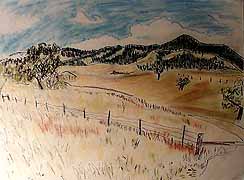
Black Hills (Peggy)
|
We chose to leave our tent pitched by the brook, and circle the
hills, starting out for Mt. Rushmore. The road from our camp was
a narrow serpentine blacktop, twisting and spiraling steeply up
and vertiginously down through the dark ponderosa parklands. Virtually
no understory, but occasional breaks of mountain meadow, and sudden
views of jutting pinnacles and great domes of sedimentary and
granite rock. An altogether bold and muscular place. One-lane
tunnels ninefoot by ninefoot kept us alert, as did the shoulderless
drop-offs alongside. In a couple of places there were ‘pigtail
bridges’ where the road curved round in a spiral on trestles and
passed under itself.
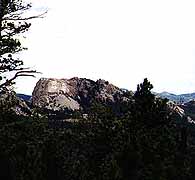
Mt. Rushmore
|
Suddenly, framed in a stonecut tunnel there was Mt. Rushmore.
In fact, that is the only view uninterrupted by construction.
The locals say the park has been “Washingtonized”, and the foundations
for bigger car parks and information centers are well in progress.
Maybe just as well. The lot was FULL, on a September Sunday. I
can’t imagine it in high season. The state of South Dakota provided
the initial financing for this monument, way back when, to bring
tourists to the area, and it’s proved a great investment. Now
the feds want to play, too. |
My initial response, upon finding the view from the lot blocked
by a large colonnade of granite pillars cum gift shoppes, was
disgust, but once up into the memorial way leading toward THE
VIEW, I switched horses. This neo-Romanizing way out in the hills
is somehow apt. Making a processional way to a granite hill somehow
fits. Yes, we have chiseled away at the mountain and put Great
American Portraits on a mountainside.. but isn’t that part of
the story? The exaltation of the individual. Isn’t this our ancestor
worship, and our nature worship, all curiously stirred together?
From afar..like Maine.. Mt. Rushmore is a tourist curiosity, perhaps,
or a memorial to four dead presidents, but up close the stew is
richer. For one thing there is a fifth personage honored here:
Gutzon Borglum, the sculptor. His presence rises up with the rocks.
Then there is the setting, this rugged mountainous parkland that
jumps out of the high plains. Now, tourist traps make me very
uncomfortable, unless they are honkytonkcomic, so I was surprised
to be moved by such a dubious icon as Mt. Rushmore. I find monumental
sculpture, generally, a cheap trick. It awes us by scale, not
content, or artistry. But here is the premier American artform,
portraiture, done to scale with the place, the American West.
And it works. Hats off to Borglum, and to us.
| I might add that Jefferson comes off rather badly in the portrait
department..and then there’s TR. Teddy is one of Peggy’s heroes,
but is he one of the four horsemen, part of the supreme pantheon?
Borglum thought so, although the promotional arguments of his
day were half-hearted.. all about the Panama Canal and Trust Busting
as big steps in bringing the continent and people together, blahblah.
From this distance TR belongs on Rushmore because he was an Easterner
transformed by the West. Washington was the indispensable man,
Jefferson sang the song and envisioned manifest destiny, Lincoln
(of the West) held us together, and Teddy lived out the westering
dream. TR is the more real to us, perhaps, because he hasn’t been
iconized into a higher heaven. Read his books, especially The Winning of the West. Although, inevitably full of his rahrah, they tell our mystery
tale.. about the frontier. |
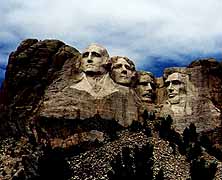
4 Horsemen
|
From Rushmore we completed our tour of the Black Hills with a
stop at Sylvan Lake for a walkabout. The lake is at the top of
the park and climbers were rappelling off Harney Peak in the background
while mythic figures of stone rose out of the waters before us.
Some masses of stone have a powerful presence and these granite
personages were a cthonic counterpoint to the chippings at Mt.
Rushmore.
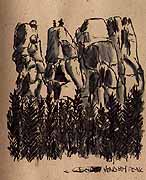
Harney Peak
|
We rode the rollercoaster back to bisonville and tried to smother
ourselves with another wet wood fire. As the emigrants did, so
we have to learn (or relearn) the little details of camping. That
using an aluminum spaceblanket over you make your bedding a sodden
sweatlodge. That camping in a stream valley beside a mountain
puts you in a cold draft. That you can’t argue with wet wood.
But the list of petty miseries would make you cry over your keyboards.
It rained both nights we spent in Custer State, and we figured
that three was too much, so we broke camp and went in search of
new wonders to see...besides the dead elk in the back of a hunter’s
pickup on the way out of camp. (Amazing rack..what a grand animal.)
|
It was my turn to be the cause of a museum stop: the HIGHLY ACCLAIMED
NATIONAL MUSEUM OF WOODCARVING in Custer. You have to admire these
mom-and-pop museums. First, having the nads to charge $6 per to
get in, then having coin-operated exhibits inside. This MUSEUM
featured the collected animated woodcarvings of Dr. H. Niblack.
Well, what can I say? The carved cowboy-booted furniture may have
been the best. Or was it the old lady (full sized) in the outhouse
you could disturb? Or... in fact, it was an endless collection
of hideous mechanized carvings, and I promise NEVER to bequeath
a carving museum, ever.
We had intended to drive 60 miles south into Nebraska to see THE
WIDELY ACCLAIMED MUSEUM OF THE FUR TRADE, but the Niblack impresarios
(since 1967) told us we better call first, as the old couple who
ran the place might be out napping. We decided not to risk another
mom-and-pop show, and let’er smoke for North Dakota.
Where we are now, at our favorite modem jack .. a Super8 .. in
Bowman. Peggy has jumped into a warm John Grisham, so this will
go out solo voce.
9/23.. Deadwood.
We did stop in Deadwood to look for Rocky Raccoon, by the way. There’s nothing as dead
as an easy money town on a Monday morning, which may excuse my
lapse of memory.
| Approaching Deadwood from the south the first thing you see is
a towering mine tipple, hanging over the skyline, with a big white
industrial shed perched on top of the black tailings. The Homestead,
biggest gold mine in North America. The big shining still lords
it over Deadwood after 100 years, and tourists from Omaha and
Wichita still flock there to find it. Only now they play the slots
and the BlackJack tables instead of panning the creeks. A town
that canonizes Wild Bill Hickcock and Calamity Jane can’t be all
good. |

Homestead Mine
|
We’d stopped for a bite, but the only eateries were casinos. That
meant the prices were low, though, so we were content to listen
to the wurlitzer musak and the payoff fanfares. The neon and chrome
glisten 24 hours a day in these places, and it was hard to guess
the time once inside. In fact it was 11:30AM, and they were still
on the breakfast menu. That kind of place. Peggy pleaded with
the waitress for something green, which caused a commotion in
the kitchen. In the end the waitress brought a sliced raw zucchini
(how did they know about Mainers and zucchini) with sour cream,
shaking her head about such exotic tastes.
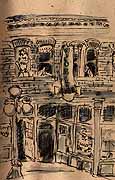
Ladies of Deadwood
|
I still contend that a chain of vegetarian restaurants with their
own greenhouses could succeed in America, but they’d have to sell
the green stuff as some foreign cuisine. After a gambler’s breakfast
I strolled the main street, looking for a showdown, or someone
to brag to....or some trace of Rocky, or Nancy, or Dan. I’d been
humming that damned tune for two days and I expected it would
be playing in at least one saloon. All I heard was the entire
Roy Orbison canon. Why is it that all smoky barrooms featuring
slots and shots have the Orb crooning low on the juke? And is
it true that widow ladies from Dubuque don’t die, they just play
the slots forever? Deadwood may be wild on Saturday night, but
it’s a sad place full of deadeyed Dicks and Janes on Mondays.
The only action was the lingeried lady-mannikins in the windows
above Wild Bill’s Bar. Rocky’d checked out. |
Descending out of the Black Hills we found someone had poured
bleach on the landscape. The dark ponderosa pines which give the
hills their name thinned out, clung to the last hillocks and ridgelines,
and then it was dry grasses for a million miles. Forgive me if
I can’t seem to stop wondering on this higher plain. Imagine a
huge beige room with one black spot on the wall. Every subtle
detail stands out like that in the Dakotas. Here is an illuminated
surface of shades so close, and yet with endless variations, from
the palest yellowgreen through all the light browns to an alkali
white...and across such a canvas the shadows of clouds come as
a shock.
Today the sky was full of inflated cumulus, white, gray, and black,
hanging in an iridescent blue, so close overhead you could almost
touch them.. and their shadows slid over the grasslands bringing
swells and dips into relief in their passage. Almost flat and
formless in the glaring sun, it was the shades of the big sky
dancing that gave texture to the earth.
|
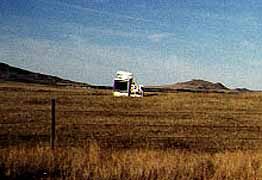
"Open Range"
|
Distant buttes and lone mountains stand up like waymarks on a
sea journey, but no ocean looks half so vast, because it is without
definition of the middle distances, and is never seen (in a boat)
from such heights as atop prairie swells. And that big sky all
around. This is a hard place to be small minded. Or if you are
it will crush you. The way small details loom large is like small
town life anywhere. Life is in the little things. A dead badger
on the shoulder. A herd of antelope spooking and bouncing off
when you stop the car. A touch of red flowers along an alkali
stream. The intense yellowgreen in a low seep. A change in the
earth tones. A change of cropping. This landscape demands all
your attention to appreciate its fullness. A place that can shock
you to silence with its scale, and move you with a fenceline,
is a wonder. I can’t imagine anyone out here capturing it on canvas,
or anyone back there understanding if they did. We are full up
to our eyebones with it, and its right outside waiting for us
in the morning. G’night little doggies.
9/23... TR’s ranch.
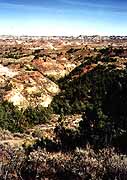
Badlands
|
Riding across the big empty in western North Dakota, with bleached prairie to the horizon,
you suddenly come to a brink and look down into a mudscape sculpted
by gigantic children: the Dakota badlands. This is the place where
Teddy Roosevelt bought shares in a ranch, then started his own.
The place, he said, that made him President. It is wild enough
to shake you out of an urban complacency, to be sure. |
The earthshapes look like molten muck, baked and carved. Apparently
that’s close to the truth, as much of the techtonics resulted
from burning lignite which melted the sedimentary overburden,
which slumped into the yellow and salmon crazyclay now exposed.
Megacotta. The sparse vegetation clings to narrow niches defined
by moisture. Down in the bottom, along the Little Missouri, the
cottonwoods thrive, the grasses are rich and green, and the buffalo
roam.. at least that’s where we saw one.. hard by the comfort
station in the campground. Do we see a pattern here? In the sheltered
coulees aspens and cottonwoods were turning bright yellow with
the first frosts, while the junipers and the sages dotted the
prospect with blackgreen and dusty ultramarine. We stopped to
try and draw a draw, but our sixshooters were too slow. Tough
stuff, these subtle hills.
We picked up a copy of TR’s book(s) about his ranching days, illustrated
by Remington, which was missing at the Bowdoin library all year.
His clarity of prose is just as refreshing as the wind up a coulee.
|
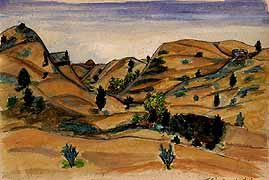
TR's Ranch (Bryce)
|
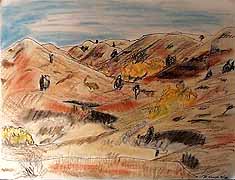
TR's Ranch (Peggy)
|
We considered camping with buffalo again, but that breeze WAS
cool, and the day was still young, so we sidled over into Montana,
and did the sights of Wibau. That took us til closing time.. the
statue of Wibau, himself, and the one restaurant, that is. Then
we decided on another Super8 (because it was the only lodging
available). There we were surprised to discover that Mr. Modem
won’t recognize a whiny dial tone, so I didn’t get to send some
snappy prose to you eager listeners.. |
hello.. are there any listeners out there? Maybe you’re waiting
for Peggy:
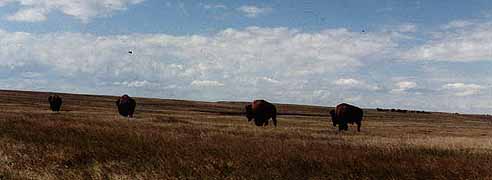
(Memo # 19)
Sept. 22 - Badlands, Buffalo, and Black Hills
Who? settlers, ranchers, tourists
What? badlands, a type of landscape
Where? North and South Dakota
When? always
How? difficult land to travel, farm, ranch
Topics: Badlands and badlands, Black Hills, Mt. Rushmore, TR.
Questions: Why are the Black Hills called black? What and where
are the badlands? |
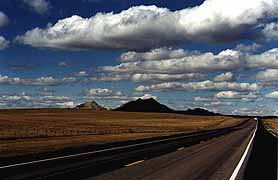
Dakota Highway
|
So far the most beautiful states we’ve seen have been Iowa and
South Dakota. I am amazed I haven’t read more about them. Iowa
was smaller scale, a patchwork of fields of different crops with
lovely green river valleys. The Dakotas are open and vast. The
colors are subtle, the horizon endless. Crossing the Missouri
River at Chamberlain, we began to see the amber waves of grain,
only they were beige and wheat and taupe with subtle changes of
hue. Very beautiful and lonely and vast. Rolling swells. Then
you begin to see the weird upthrust shapes on the horizon. You
get closer and then are in the badlands, at Badlands National
Park, SD., endless masses of fractured buttes. Some of the landscape
looks chiseled, other parts look like hasty mud pie jobs.The roads
twists around and up and down. The colors change from beige to
pink and umber.
Badlands
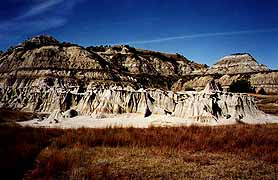
Badlandscape
|
At Badlands, we took the tourist loop and then headed off on a
dirt secondary road. Suddenly we were alongside 4 buffalo who
ignored us. We got to watch them close at hand, grazing and dozing
and ambling along. They are quiet, healthy, majestic animals.
I was surprised that the heavy coat is only around their forequarters.
We stopped in a grassy valley, took a walk, and scared a coyote
out of his drinking spot. Back in the car and we drive into the
middle of another small buffalo herd just crossing the road. Incredible
to glance up at a butte and see a buffalo outlined against the
sky.
|
All the national parks seem to have buffalo herds and “Beware
of Bison” signs. I had every intention of doing so until a buffalo
blocked my path as I walked at dawn toward a campground bathroom.
Stopped me dead. We’re told they are “quite aggressive” and a
sign of impending attack is a tail lifted right up. Hard to see
the tail in the predawn gray. I decided to take a more circular
route. He didn’t seem to care one way or the other. When I mentioned
the campground buffalo, the manager said he had to “shoo” eight
or ten out a week! Glad you told us!!
There are two ways the word “badlands” is used. It IS a generic
term for a certain kind of landscape - broken buttes and many
small canyons. So many states have "badlands" in this sense, both
North and South Dakota, Montana and others. However, THE Badlands
(with a capital B) seems to be the national park in South Dakota.
This is why it’s so confusing when you read about the area.
|
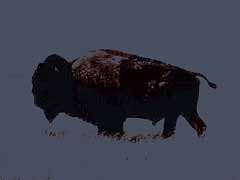
Good Morning
|
Mt. Rushmore
The Black Hills are truly beautiful. We would call them mountains
in Maine The softwood trees really do look black at a distance
and are a shock next to the subtle plains grasslands. There is
no undergrowth, so the Black Hills seem like an English manorial
park with grass and small meadows and glades throughout which
buffalo and elk and deer graze. A large area had been hit by a
fire some years back. There are lovely campgrounds and trails.
We camped two nights. We drove to Mt. Rushmore.
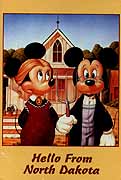
Iconography
|
Our first sight of the mountain was framed through a small tunnel
as our mountain road brought us in view. It’s breathtaking. First
of all I didn’t really know how high the cliff is that was carved.
You can’t just walk up and gaze up at the faces, they are VERY
high up at the top of a mountain and the viewing area is basically
across a valley. This makes the feat of carving them even more
impressive. The Parks Service has added a stone processional way
from the parking lots to the view. Impressive. |
And you have to be astounded at sculptor Gutzon Borglum’s vision.
The scale is incredible, the work it took outrageous. Tons of
rock were removed. It took fourteen years (1927-41), 380 workmen,
and $989,000 to complete.
| There are sculptors working in that scale today - Christo wraps
huge buildings in canvas and surrounds chains of islands with
pink plastic. Stan Herd makes huge pictures visible from the air
in fields - i.e. he both plants specific things to get certain
color and also cuts parts of fields to attain details. A second
mountain sculpture (of Native American leader Crazy Horse) is
in the process twenty miles+ away, and from a distance you can
really see that they are cutting huge chunks off a mountain. |
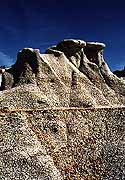
Earth Sculpture
|
Borglum first thought of two full length figures. The choice of
TR was his. Why? Borglum admired him, barnstormed for him, saw
a connection to the Dakotas since TR owned ranches here. The sculptor
may even have welcomed controversy as free PR. The faces seem
to vary a lot in the skill of the carving. Washington seemed less
detailed. I would not have recognized Jefferson if I hadn’t been
told it was him. Lincoln and TR seem the most detailed and true.
A local woman told us she visited them in all weather to see them
in bright sun and shade and winter. The sculpture was intended
as a tourist draw. It is and deserves to be, a national icon that
didn’t disappoint.
Other Badlands and TR
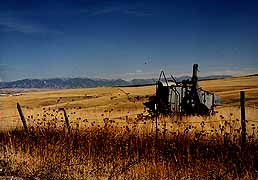
High Prairie
|
I really wanted to see the part of this country identified with
TR, so we set off for North Dakota. It was about a five hour drive
across open grasslands with occasional buttes. TR actually owned
3 ranches - The Maltese Cross and Elkhorn were two. He came out
in the early 1880’s to hunt and got fascinated by the life. He
invested that first year with two partners - $14,000 for 400 cattle.
He went back to his job in the NY legislature, but returned for
visits several times. |
After the sudden deaths of his wife and mother TR retreated to
the ranches for two years. In 1886 there was a hard winter and
he lost many cattle. Eventually he went back east. He is quoted
as saying that he would not have become president without the
experience in North Dakota.
The park itself is glorious, a stretch of badlands quite different
from those in South Dakota. The Little Missouri River ambles through
so there are cottonwoods groves in the flats and a fair number
of hardwood trees, so we saw a real fall. The colors in the rocks
and buttes are black and brown, in South Dakota they are much
more pink and auburn. In this N.D. park we saw, again, buffalo,
elk, deer, one large rattler on the road (they like the warmth)
and colonies of prairie dogs.
|
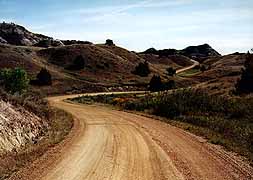
The Western Road
|
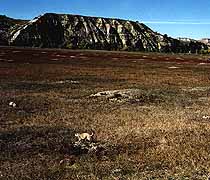
Prairiedog town
|
I’d say they have a prairie dog problem. Their “towns” cover ten,
twenty, fifty acres with hole mounds every ten feet or so, the
animals scamper about, totally unafraid. They are RIGHT by the
road and they have even burrowed up UNDER THE ROAD. We saw one
or two news holes in the pavement and a LOT of patches. The road
maintenance crews must hate them!!! |
| At the visitor center is TR’s cabin. I had seen pictures and was
eager to view it in its right setting. Well, I saw the cabin and
it was great, but...... once again the facts are humorous. This
IS the original cabin, but it’s VERY well-traveled. It was taken
east several times for various world fairs, during and after TR’s
presidency. Its current site is seven miles from the original
ranch. Well, Plymouth rock has been moved all over too! |
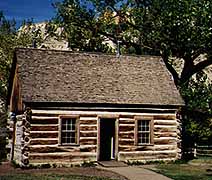
TR's Cabin
|



















